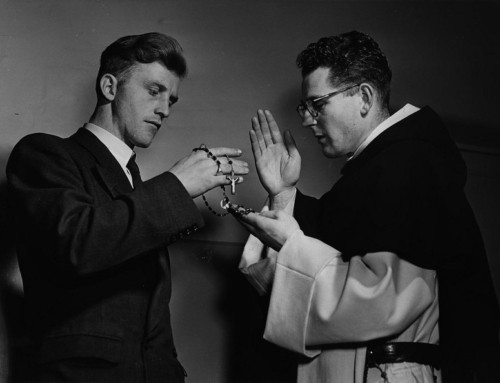From the Church’s beginning, people have accused her of bringing religion to the masses. Of course it has. When people receive the good news of the gospel, they want to share it with their neighbors. And it is their hope that these neighbors also see the light of Christ because they know that it will bring them everlasting joy. Obviously, the Holy Spirit was at work to bring the Faith to the people, but it was also due to the men and women that were so passionate about Christ and worked so hard to spread the gospel throughout the ancient world. Though one could call them secondary instruments of the Holy Spirit, one should not discount their contribution.
While it is quite anachronistic to say there was some heavy-duty marketing going on in the first century, it is hard not to see it looking back with our 21st-century eyes. Given this information, one wonders if it is possible to use the same tools that were so successful 2,000 years ago for our 21st-century mindset. After all, few would deny that in the Western World, Catholicism has experienced a dramatic decline in fervor, if not in numbers. Marketing techniques have changed in the last few millennia, particularly with technology. Is it possible, therefore, to harness these new techniques to help evangelize? It is an interesting proposition, to be certain, and one that some people might find a bit distasteful, but there is no harm in giving it a bit of scrutiny.
There is no question that Christianity grew well beyond its Jewish foundations from its very inception. Jesus and his ragtag crew of Apostles scoured the Jordan River Valley converting people en masse. Each of the four evangelists recount multiple times where crowds followed Jesus wherever he went. Even the Jewish writers at the time were alarmed at their adversary’s remarkable success. While it is true that Christian numbers were growing, if it were not for the eloquence and marketing genius of a certain convert to the Faith named Paul, it is difficult to determine whether Christianity would have spread beyond Palestine and the Jewish people.
Endorsement
Almost all good marketing campaigns have endorsements. These days it tends to be actors, musicians, movie and television stars, sports personalities, and other people in entertainment. But prior to our age, famous people tended to be rulers, politicians, rhetoricians, writers, poets, and others that had heavy educational backgrounds. Regardless of the age, the adage “If it’s good enough for them, it’s good enough for me” still applies. The psychological advantage of being in communion with someone else, someone famous, cannot be discounted. In the absence of any tangible information regarding a product, including religious beliefs, points automatically go to the preferences of a recognizable figure. In our age, for example, Tom Cruise has increased the awareness and membership in the Church of Scientology, despite the fact that most mainstream Christians frown on its theology.
Scripture tells us that Paul was not just anti-Christian, but that he was a famous anti-Christian, witnessing and sanctioning the stoning of Stephen. His virulence was well-known throughout Palestine and beyond. According to the Acts of the Apostles, his reputation for villainy reached Damascus, despite Jerusalem being nearly 150 miles away. So when he went through his famous conversion, his reputation grew on both sides of the Jewish and Christian divide, regardless of the side on which he finally settled. Nevertheless, he went from being the Jews’ most ardent champion to being Christendom’s most popular evangelist.
The Charismatic Personality
Every organization starts with one or two individuals that act as magnets to attract individuals to certain causes, for growth, and for membership. History is punctuated by certain individuals who have had exceptional oratorical and rhetorical skills. Paired with empathy, they seemingly have had the ability to read people’s hearts and convince them to aid their cause. Such a capacity may sound incredibly self-serving. However, it really depends on the intention of the individual in question, which of course depends upon his respective morality.
Jesus was the quintessential Pied Piper, drawing people from all over Galilee—and, indeed, from all of Palestine—to hear his message. Jesus was exactly the opposite of self-serving, and he strove to help people to not just recognize the Kingdom, but also to seek it with all their hearts. Paul took up where Jesus left off and traveled to countless locations, setting up local churches wherever he went. Obviously this could not have been done if he did not have the strong magnetic personality necessary for success. His corpus of letters attests to his strong personality, revealing moments of anger, tenderness, strict discipline, and paternal love. While these characteristics do not necessarily indicate a strong charismatic personality, the fact that his foundational churches survived months between visits (though not without difficulties) does; and durability of these early communities is a testament to his influence and talents as a leader.
Barriers to Entry
An additional marketing maneuver is to remove barriers to entry. This of course expands the potential market base, since those who had been previously outside are now inside. In 1989 the Toyota Corporation was forced to face the reality that they were a Japanese automobile manufacturer, known for cheap but economical vehicles. The wealthy and influential bought only luxury goods from the likes of Cadillac, Mercedes Benz, and BMW. No matter what Toyota did to improve the physical comforts of its product, public perception ensured that its product was synonymous with “cheap.” In other words, by virtue of the class of product it was creating, Toyota always had a price point ceiling equal to the value of “economy”—which at the time was not much. Therefore, any comfort improvements had a direct, negative impact on the bottom line, since they did nothing to attract additional customers other than the company’s existing base.
In reaction, Toyota chose to take a different tact. It created a wholly-owned subsidiary called Lexus, which manufactured only expensive vehicles. While those on Wall Street knew of the relationship, most people did not. The Lexus branding became synonymous with Japanese luxury, and it attracted thousands and thousands of new potential buyers in North America, becoming one of the most successful product lines ever. Toyota removed a barrier to entry and subsequently opened its market to those who thought to buy above mere “economy.”
Whether it was intentional or not, the Apostle Paul did something quite similar. As is readily evident in Paul’s Epistle to the Galatians, Paul and Peter had some heated discussions over how “Jewish” Christians needed to be. At various times in his ministry, Jesus made his gospel available to everyone, not just the Jews. However, this led to the argument as to whether Christian identity needed to be based on Jewish customs and identity. An action of Peter could have been interpreted to say that, yes, Jewish customs should be maintained. But Paul said no. If the newly formed Christian Church required all newcomers to adopt Jewish customs, it is likely that membership would have floundered. Observances such as circumcision and strict dietary laws, which fell under the Mosaic Law, were not simply laws; they were culture.
The idea that the Gentiles would need to adopt a completely new (and more importantly, foreign) culture just for the privilege of becoming Christians seemed doomed. And while not entirely on the same scale, it would be much more akin to asking a culture of meat eaters to suddenly become vegetarians: possible yes, but probable no. Ultimately, the resolution of the matter was settled upon theological grounds, not through an opinion poll or a marketing study. Nonetheless, the human dynamics of this disagreement for the ‘sellability’ of Christianity should not be neglected. Paul argued against Peter and eventually won, despite the fact that Peter was effectively the leader of the burgeoning religion. It should be noted that this humility toward the efforts of a subordinate could also have been attractive to newcomers.
Location, location, location
It is no secret that having a presence in the most visible places increases recognition and accelerates growth. It is precisely why 5th Avenue in New York, Rodeo Drive in Beverly Hills, and rue du Faubourg Saint-Honoré in Paris attract some of the most expensive shops. They become magnets for buyers and sellers, those who want to be seen, and those who are aspiring for retail greatness. They also command the highest rents in their respective cities. Yet, despite the rent, all of the shop owners still congregate there not for the effect of losing money, but precisely the opposite. With the influx of foot traffic and brand recognition, such well-placed shops can generate more than enough sales to justify their presence.
Commerce aside, people also congregate in places of importance: seats of government, centers of pilgrimage (e.g., shrines and around the relics of important people or events), foci for culture and religion, and places of education. It is often commerce that enables these auxiliary nexuses to form. Nevertheless, it is at these points where a budding religion can not only flourish, but also be launched into other communities via merchants using their existing trading routes.
Such was the design of Paul. In his three voyages he managed to visit all of the important cities in Asia Minor (now Greece and Turkey). And while not all of them have maintained their prominence in the present, they certainly had their influence in the ancient world.
And so, when Paul went on his missionary journeys, he set off far and wide. It is estimated that Paul walked more than 10,000 miles (outside of nautical miles) in his journeys. This is not the action of someone who is lukewarm with his mission. He went to key populated areas: Athens, Corinth, Ephesus, Thessalonica, Philippi, Colossæ, and so on. While some of these locations are not burgeoning places in our modern world, they certainly were in the ancient world. Essentially, Paul incorporated theology and the then-existing social networks into his endeavor, and thus the message of Christ spread throughout the Roman Empire.
Need for Evangelization
The big question in our day and age is whether or not we can achieve what Paul did in his. As mentioned earlier, it might be anachronistic to think that Paul was one of the most successful marketing individuals ever. Nevertheless, one thing that he did not do was to accept the status quo. Were he to have done that, Christianity might still be limited to a few small congregations, splintered off of the Jewish faith—still trying to figure out if it has a place in the world (and probably to the ire of Jews as well).
According to a 2008 study from the Center for Applied Research in the Apostolate, 23% of self-professed Catholics regularly attend Mass. Even within the six years since the publication of this study, this number has probably dropped by some amount. If there are some 70 million Catholics in the United States, then the number of people in the pews is somewhere around 16 million people. Given that there has been a recent push for a so-called New Evangelization, then clearly this evangelization cannot be in the parishes alone. If it were, then it would address a mere 5% of the US population (from an estimate of 300 million). Furthermore, parochial-only efforts would be literally “preaching to the choir.” This, by definition, has little to do with evangelization, let alone “new” evangelization. What about the 95% of the population that does not practice the Catholic Faith? What about the very sizable percentage that never hears the Word of God and that never receives the sacraments?
There are tens of millions of US citizens who go through their daily lives without ever thinking about church, something that has changed significantly in the last 50 years. How do we reach these people? We may not be able to duplicate Paul’s success without having all of his tools in play, but we can set up the lattice or framework that would allow for at least some of it. But then one or two prominent individuals, charismatic individuals, eloquent individuals, savvy individuals, would have to rise to the occasion. Who might this individual be?
This person would have to go directly to centers of influence, challenge the status quo, and debate the secular forces on their home turf. It, of course, would not be easy, and it may initially seem like things could end in failure. After all, Paul was eventually beheaded in Rome. Nevertheless, his legacy remains, and the Holy Spirit helped to ensure the endurance of his efforts. Not only did Paul strengthen Christianity by bringing in significant numbers, but he also contributed to nearly half of the New Testament Scriptures. How is this exactly a failure?
To download a printable PDF of this Article from
Dominicana Journal, Winter 2014, Vol LVII, No. 2, CLICK HERE.



